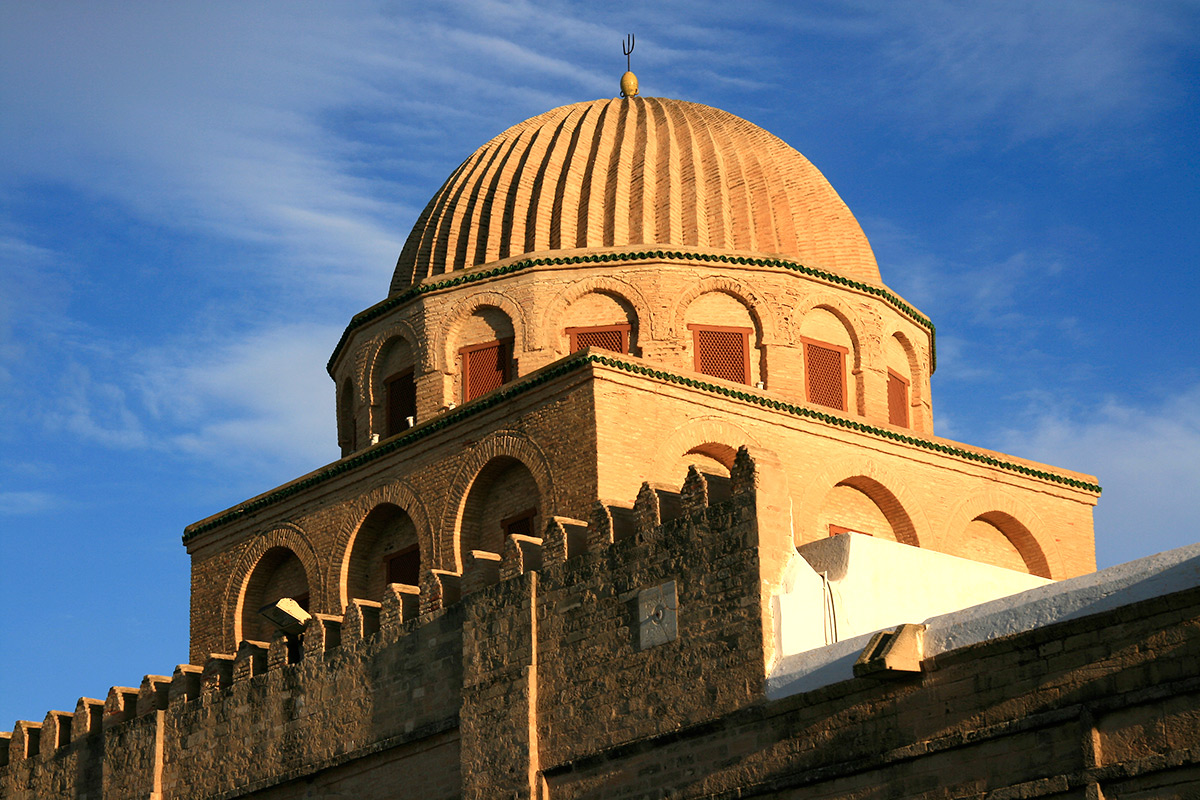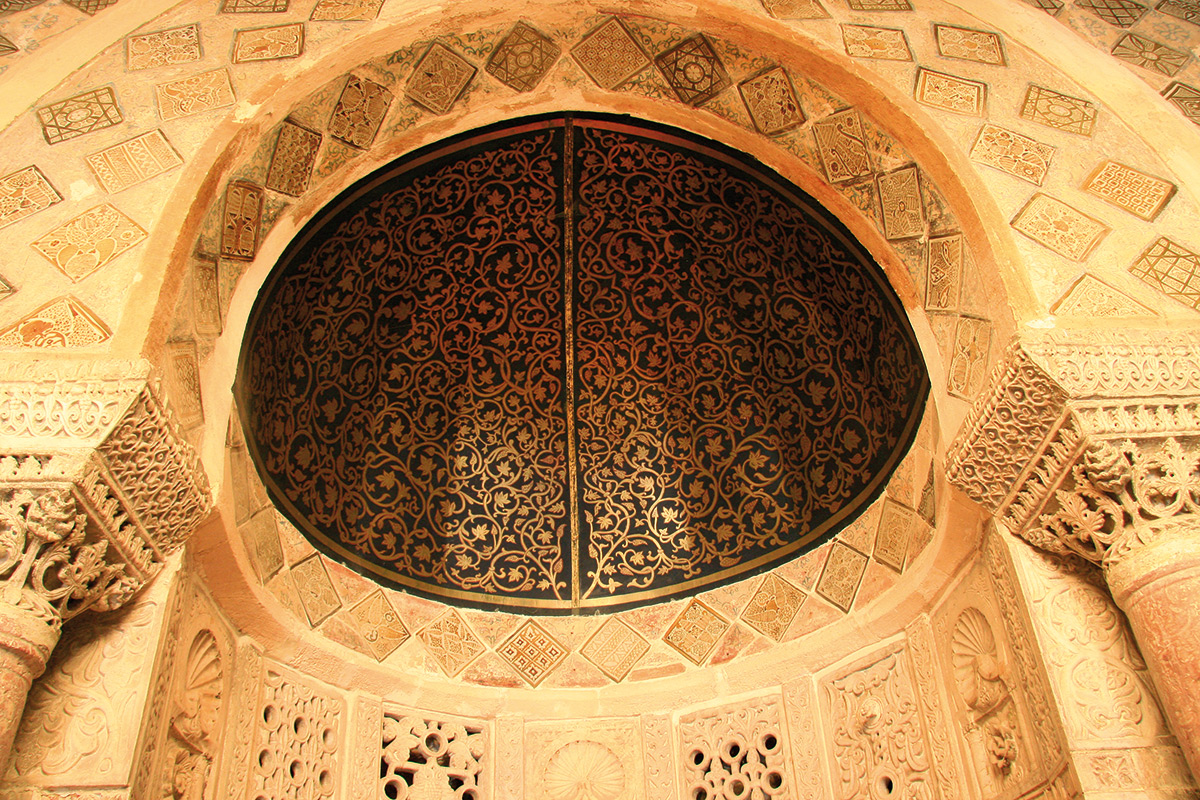The first Islamic city founded in the Maghreb, Kairouan has preserved through the centuries the aura of a holy city. Capital of Ifriqiya, the eastern section of the Maghreb, during the early Middle Ages, it was also a centre of civilisation of considerable influence.

Kairouan was founded in 670 in the precise location that the Grand Mosque now stands. The Arab general Oqba Ibn Nafi, charged by the Umayyad caliph in Damascus with conquering distant Byzantine Africa, would choose this site to build a mosque and establish a camp city.
But it wasn’t until 836 that the Great Mosque adopted, for the most part, its present appearance; Kairouan had become the capital of a powerful emirate, that of the Aghlabids.
From the outside, its thick walls bristling with numerous buttresses evoke the dangers of a bygone heroic era. On the inside, the immense courtyard fringed with arcades exudes harmony and serenity.
On one of its sides stands the austere bulk of the minaret, resembling an ancient lighthouse. The opposite side, whose elegant gallery with a double row of arcades is topped by a fluted dome, forms the facade of the hall of prayer.
From the gallery colonnade as far as the frame of the minaret door, the reuse of historical elements jumps out: The Great Mosque of Kairouan, although one of the first monumental buildings dedicated to the new religion, remains anchored within a long architectural tradition.
The interior of the hall of prayer reinforces this impression. A veritable forest of ancient columns, topped with various types of capitals, fills the entire space. This undifferentiated space, devoid of centre, but oriented towards the qibla wall that the faithful face for their prayers, is characteristic of Islamic architecture.
Located in the centre of this wall is one of the most remarkable features of the mosque: the mihrab, tall niche indicating the qibla. Covered with marble lattice, framed by columns of porphyry columns and lustrous golden-sheened lustreware tiles, it is topped with a half dome of dark wood covered with marvellous golden arabesques.
Next to it, another priceless treasure: the oldest pulpit (minbar) of the Islamic world still existing today. Its panels of carved wood, all with different decoration, make up one of the first masterpieces of the art of the arabesque.
Both date back to the 9th century. The mosque also has another masterpiece of sculpted wood, a maqsura (private enclosure reserved for the prince) dating from the 11th century.

Two robust and harmonious basins persist, the largest is 128 metres in diameter. These facilities for decanting and storing water were indispensable to the wellbeing of a large city in an arid environment.
Sacked during the invasions of the 11th century, Kairouan would cede its position to Tunis and go into decline. It would nevertheless retain its prestige as a holy city, carrying on the memory of the first battles and their martyrs.
In the 17th century the Bey of Tunis built a superb mausoleum, known as the “Mosque of the Barber”, for one of them, Abou Zamaa el-Balaoui. Located outside of the medina enclosure, it is part of a charming complex of many rooms and courtyards tiled with multicoloured ceramic, adorned with delicately carved plaster.
At once mausoleum, school, mosque and religious foundation, this monument is a magnet for religious fervour towards the memory of Abou Zamaa, companion of the Prophet, who the Tunisians nicknamed Sidi Sahbi.
Kairouan is home to many other buildings speaking to its pious vocation, such as its many zawiyahs (religious foundations and headquarters of brotherhoods) and its Barrouta well which would be miraculously linked to the Zem-Zem well in Mecca. Other monuments represent priceless examples of medieval architecture.
But Kairouan is also the medina with its simple and fascinating charm, washed in white and in blue, dotted with ribbed domes and surrounded by crenellated ramparts, which the Tunisian historian Hassen Hosni Abdelwahab classed as the “jewel of the Maghreb and pearl of Arab architectural heritage”.
A veritable museum of historical art, the Great Mosque possesses the largest collection of Roman and Byzantine capitals brought together within an Islamic monument. They can be found in the galleries surrounding the courtyard and in the hall of prayer, where the differences in shape and colour of the columns and capitals blend into the harmony of the whole piece.
The Great Mosque’s mihrab, the alcove indicating the direction of prayer, is noteworthy for its leafy golden arabesques, its metallic-sheened lustreware tiles imported from Iraq and its columns of red porphyry (a type of volcanic rock). It is topped with a dome whose carved interior decoration (rosettes, shells) call back to its Umayyad heritage.
The small Mosque of Three-Doors is exceptional for its age (9th century) and for its its facade, richly carved with inscriptions and foliage motifs. It is the oldest known such example in Islamic architecture.
The zawiyah (religious foundation) of Sidi Abid al-Ghariani would have been built in the 13th or 14th century. It is a beautiful example of the austere and elegant architecture of the Hafsid period: a courtyard paved with interlacing geometric patterns in marble, an arcade with black and white archstones, a pyramidal dome covered with green tiles...
Built in the 17th century, the mausoleum of Abou Zamaa, or zawiyah Sidi Sahbi, borrows both from the traditional architecture of Kairouan (fluted dome) and from that of Al-Andalus (minaret). Its decoration of carved plaster and its walls covered with polychrome tiles of Spanish or Turkish inspiration make up a marvellous decorative repertoire of this period.
The zawiyah of Sidi Amor Abada, megalomaniacal 19th century character adored by the population, has no fewer than six domes in the traditional Kairouan style.
© G. Mansour, “Tunisie, patrimoine universel”, Dad Editions, 2016
Kairouan was declared a UNESCO World Heritage Site.
More about the World Heritage Sites in Tunisia